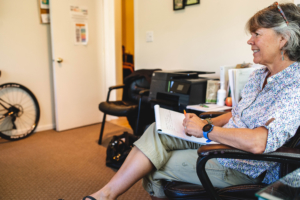The Importance of Social Recovery in Mental Healthcare
 Recovery is a term frequently used by people with mental health issues to describe their efforts to live meaningful and satisfying lives. Colorado Recovery approaches mental healthcare based on a path of self-reliance through developed practiced skills. This non-institutionalized social recovery offers comprehensive levels of care supported by an expert medical and clinical team, engaging patients in increasing community participation.
Recovery is a term frequently used by people with mental health issues to describe their efforts to live meaningful and satisfying lives. Colorado Recovery approaches mental healthcare based on a path of self-reliance through developed practiced skills. This non-institutionalized social recovery offers comprehensive levels of care supported by an expert medical and clinical team, engaging patients in increasing community participation.
Shulamit Ramon is mental health research lead at the University of Hertfordshire in Britain. In a 2018 article for the International Journal of Environmental Research and Public Health, Professor Ramon looked at the place of social recovery in mental health and social care services, alongside personal recovery.
“As distinct from personal recovery, yet inter-related to it, social recovery includes the components of interdependence with others, connectedness, recovery capital, and social capital, as well as the impact of collective culture and the structural elements of our socio-economic-political system,” wrote Ramon. “To add to the complexity, the impact of each element on one’s identity, in interaction with how one is seen by others, needs to be taken into account.”
Ramon points out that social recovery was initially defined by the late Colorado Recovery founder Richard Warner in Recovery from Schizophrenia as economic and residential independence with low social disruption but has since been expanded to refer to people’s ability to lead meaningful and contributing lives as active citizens.
People with mental health disorders are no longer just the recipients of treatment but are encouraged to participate in joint decision-making. “Existing research demonstrates that most people experiencing mental illness are able to make decisions and have the mental capacity to do so most of the time, including many of those who are in an acute admission ward,” wrote Professor Ramon. “This is hardly surprising to those of us coming from the recovery perspective, given that the intellectual and social capacities of many members of this group have been demonstrated by the strengths approach, the valued contribution of peer support workers, and the impressive contribution of service users [patients] who have championed recovery.”
Social recovery is a “co-production” of therapists and patients who “have not only strengths to share in a joint project, but that co-production can enhance the power they have within such an undertaking and with it their social standing and identity, as well as enriching any given project.”
This kind of empowerment is central to the Warner Model utilized at Colorado Recovery. It includes a residential treatment program, a transitional program, and an intensive outpatient program, and a “clubhouse” community mental health service model. “Treatment should include social rehabilitation,” wrote Dr. Warner in The Environment of Schizophrenia. “People with schizophrenia usually need help to improve their functioning in the community. This can include training in basic living skills; assistance with a host of day-to-day tasks; and job training, job placement, and work support.” The treatment team at Colorado Recovery recognizes that their clients share with them a need for a sense of community, meaning in life, and self-respect.
Professor Ramon also listed active citizenship and employment as important aspects of social recovery. “The emerging focus on co-production and active citizenship to overcome social exclusion and to foster social inclusion of people experiencing mental ill health is encouraging, and hopefully will also enhance the implementation of shared decision making at all levels. The message of social recovery lies in the need to include the social context in understanding, analyzing, and responding to people’s mental health difficulties. This author, for one, shares Warner’s optimism while being aware of the obstacles to achieving social recovery for all who need it.”
At Colorado Recovery it is our mission to help adults with serious mental health issues stabilize their illness, minimize symptoms, improve functioning and enhance each person’s social inclusion, quality of life, and sense of meaning in life.
If you have questions about our recovery model or our services to treat schizophrenia, bipolar disorder, and similar mental illnesses, call us at 720-218-4068 to discuss treatment options for you or the person you would like to help.

 The recovery model is a holistic, patient-centered approach to mental healthcare. This model has gained momentum in recent years and is based on the simple premise that it is possible to recover from a mental health condition.
The recovery model is a holistic, patient-centered approach to mental healthcare. This model has gained momentum in recent years and is based on the simple premise that it is possible to recover from a mental health condition.
 “Unfortunately, we cannot admit patients into this program who are still struggling with a full-force addiction,” says June Bianchi, Transitional Living Program Manager for Colorado Recovery. “Patients should be stable in their recovery, have a good idea what medications work for them, and should able to rely on their support system.” If clients do have substance use issues, the Colorado Recovery team will help address them and help engage that support system to avoid jeopardizing their recovery.
“Unfortunately, we cannot admit patients into this program who are still struggling with a full-force addiction,” says June Bianchi, Transitional Living Program Manager for Colorado Recovery. “Patients should be stable in their recovery, have a good idea what medications work for them, and should able to rely on their support system.” If clients do have substance use issues, the Colorado Recovery team will help address them and help engage that support system to avoid jeopardizing their recovery. Colorado Recovery utilizes six stages in its transitional living process. The first is orientation, a time to adjust to the program. “Clients identify their strengths and areas they want to work on,” explains Robitaille. “They are getting comfortable with independent transportation, time management, food shopping, preparing meals, and other life skills.”
Colorado Recovery utilizes six stages in its transitional living process. The first is orientation, a time to adjust to the program. “Clients identify their strengths and areas they want to work on,” explains Robitaille. “They are getting comfortable with independent transportation, time management, food shopping, preparing meals, and other life skills.” Bipolar disorder and major depression share some similarities. They are sometimes confused because both can include depressive episodes, but there are some key differences.
Bipolar disorder and major depression share some similarities. They are sometimes confused because both can include depressive episodes, but there are some key differences. 
